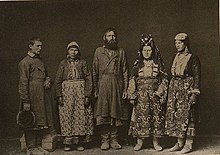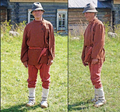|
Udmurts
The Udmurts (Udmurt: Удмуртъёс, Udmurtjos) are a Permian (Finno-Ugric)[7] ethnic group in Eastern Europe, who speak the Udmurt language. They mainly live in the republic of Udmurtia in Russia. EtymologyThe name Udmurt comes from *odo-mort 'meadow people,' where the first part represents the Permic root *od(o)[8] meaning 'meadow, glade, turf, greenery'. The second part, murt, means 'person' (cf. Komi mort, Mari mari, Mordvin mirď-), probably an early borrowing from an Iranian language (such as Scythian): *mertä or *martiya meaning 'person, man' (cf. Persian mard). This, in turn, is thought to have been borrowed from the Indo-Aryan term *maryá- 'man', literally 'mortal, one who is bound to die' (< PIE *mer- 'to die'), compare Old Indic márya 'young warrior' and Old Indic marut 'chariot warrior', both connected specifically with horses and chariots.[9] This is supported by a document dated 1557, in which the Udmurts are referred to as lugovye lyudi 'meadow people', alongside the traditional Russian name otyaki.[10] On the other hand, in the Russian tradition, the name 'meadow people' refers to the inhabitants of the left bank of a river in general. Most relevant in this regard is the recent theory proposed by V. V. Napolskikh and S. K. Belykh, who suppose that the ethnonym was borrowed from Proto-Iranian entirely: *anta-marta meaning 'resident of outskirts, border zone' (cf. Antes) → Proto-Permic *odə-mort → Udmurt udmurt.[11] During the course of the Russian Empire, Udmurts have been referred to mainly as Chud Otyatskaya (чудь отяцкая), Otyaks, Wotyaks[12] or Votyaks, all being exonyms. Today such exonyms are considered offensive by Udmurts themselves and are mainly used against those who have forgotten the Udmurt language. The Udmurts are closely related to Komis to their north, both linguistically and culturally.[citation needed] Distribution Most Udmurt people live in Udmurtia. Small groups live in the neighboring areas of Kirov Oblast and Perm Krai, Bashkortostan, Tatarstan, and Mari El.[citation needed] The Udmurt population is shrinking; the Russian Census reported 552,299 in 2010, down from the 2002 Russian census figure of 637,000, in turn down from 746,562 in 1989.[citation needed] The 2021 census counted fewer Udmurts than had the 1926 census.
Culture  The Udmurt language belongs to the Uralic family. The Udmurts have a national epic called Dorvyzhy. Their national musical instruments include the krez zither (similar to the Russian gusli) and a pipe-like wind instrument called the chipchirghan.[13] A chapter in the French Description de toutes les nations de l'empire de Russie from 1776 is devoted to the description of the Wotyak people.[12] James George Frazer also mentions a rite performed by the people in his book The Golden Bough.[14] Many Udmurt people have red hair,[15][16] and a festival to celebrate the red-haired people has been held annually in Izhevsk since 2004.[17] The Udmurts used to be semi-nomadic forest dwellers that lived in riverside communities. However, most Udmurts now live in towns. Although the clan-based social structure of the Udmurts no longer exists, its traces are still strong and it continues to shape modern Udmurt culture.[18] GeneticsAccording to the data gathered by Kristiina Tambets and others (2018), the majority (about 70 %) of Udmurt men carry the haplogroup N. The high frequency of this East Eurasian-related haplogroup is a common pattern among Uralic-speaking peoples. Most Udmurt men belong to the subclade N1c and 16.8 percent of them belong the subclade N1b-P43. The second most common Y-DNA haplogroup among Udmurts is R1a (19 %).[19] The most common maternal haplogroup for Udmurts is U (23.5%). Most Udmurts who have it belong to its subclades U2 (10.4 %) and U5 (9.3 %). Nearly as common is H (22.5 %). Other mtDNA haplogroups among Udmurts include T (16.5 %), D (11 %) and Z (6 %).[19] When it comes to the autosomal ancestry of Udmurts, around 30 percent of it is Nganasan-like.[19][21] This Siberian component is typical for Uralic-speaking peoples. The rest can be modelled to be mostly Steppe-like with a smaller eastern hunter-gatherer component,[19] or Srubnaya-like.[21] It is common for Northeastern Europeans to have a high level of Steppe-related admixture.[19] Gallery
See also
References
Further reading
External links
|
||||||||||||||||||||||||||||||||||||||||||||||||||||||||||||||||






